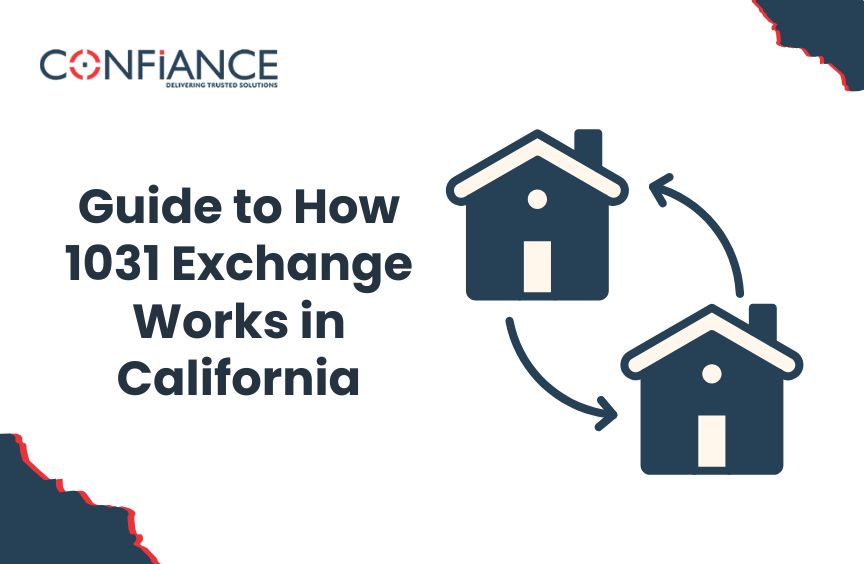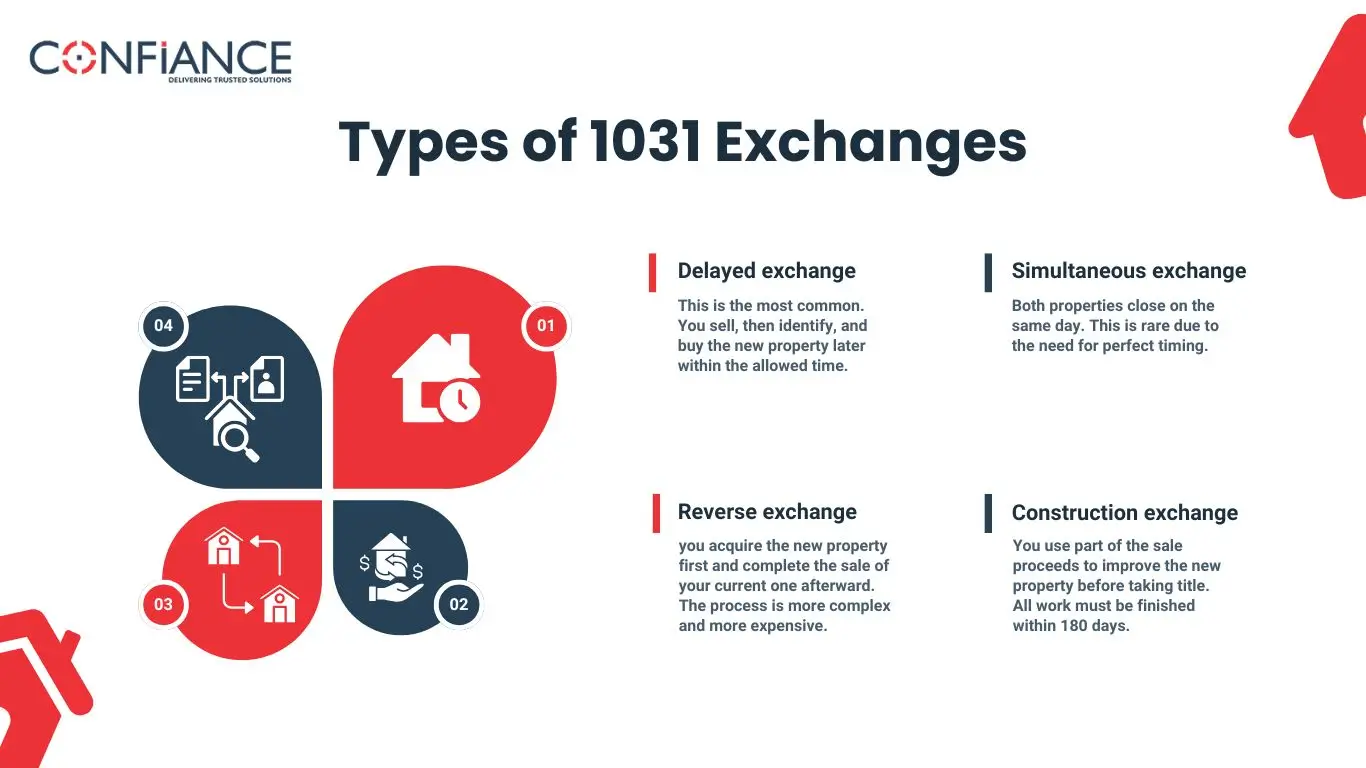
Guide to How 1031 Exchange Works in California
Many property owners in California want to grow their real estate investment portfolio without losing profits to taxes. A 1031 exchange offers a legal way to sell one investment property and buy another while you defer capital gains tax through a tax deferred exchange. It is not automatic and it does not apply to every type of property.
This guide explains how a 1031 exchange works in California, who can use it, what steps to follow, and which mistakes to avoid. If you are thinking about selling an investment property, read this before you act.
What Is a 1031 Exchange?
A 1031 exchange is a tax rule that lets you delay capital gains tax when swapping exchanged properties that qualify under IRS rules.
Real-world scenario:
For example, a landlord in San Diego might sell a small rental condo and buy a multi-unit property in Sacramento. As long as both properties are used for business or rental, and the rules are followed, the investor pays no capital gains tax now.
It allows owners to sell a business or investment property and defer capital gains tax by using the money to buy another similar property.
This is not a tax break for flipping homes. It applies to owners who hold properties for rental or business use. To meet the requirements, the replacement property must serve a business or investment purpose and be worth the same or more than the one sold.
What Is a 1031 Exchange in California and How It Differs from the Federal System
The state follows federal rules but adds extra reporting
In California, the rules match the federal system. The difference is in how the state tracks property that leaves California. If you sell a California property and use a 1031 exchange to buy in another state, California still expects to collect tax later.
The Franchise Tax Board requires you to file Form 3840 every year until you sell the new property. This helps the state keep track of the deferred tax from the original sale.
California also has strict audit procedures for tracking tax deferrals. If you fail to file Form 3840 even once, penalties may apply. The state treats these cases seriously and will eventually collect taxes if the replacement property is sold without another exchange.
How Does a 1031 Exchange Work?
A 1031 exchange involves specific actions and strict 1031 exchange rules with firm deadlines. Here’s how the full process works:
Sell your current investment property
The process begins once your existing rental or business property is sold.
Hire a Qualified Intermediary (QI)
You cannot touch the sale proceeds. A third party, the QI, holds the money and manages the exchange. This is required.
Identify the replacement property
You have 45 days from the sale to name up to three new properties in writing. These must be potential replacements.
Buy the replacement property
You must close on one of those within 180 days of selling the original property. The new purchase must cost the same or more to defer all tax.
File the correct forms
At tax time, use IRS Form 8824. If your new property is outside California, file Form 3840 with the state each year.
Quick Timeline Summary:
- Day 0: Sell your investment property
- Day 1–45: Identify up to 3 replacement properties
- Day 1–180: Close on one of them
- Tax Time: File IRS Form 8824 and CA Form 3840 (if needed)
Important Rules for California Investors
These are the state-specific details you cannot skip:
- Out-of-state tracking: If you buy outside California, the state wants to know where the deferred tax is. You must keep reporting it.
- Form 3840: File this yearly for as long as you hold the out-of-state replacement.
- Tax still applies later: When you sell the final property without another exchange, you owe both federal and California capital gains tax.
Types of 1031 Exchanges

There are four main types of like-kind exchanges under Section 1031. The difference lies in timing and how the swap is handled. Some involve buying first, others selling first. A few work for complex deals.
Not every exchange follows the same path. Here are the main types most often used in real estate:
Delayed exchange
This is the most common. You sell, then identify, and buy the new property later within the allowed time.
Simultaneous exchange
Both properties close on the same day. This is rare due to the need for perfect timing.
Reverse exchange
you acquire the new property first and complete the sale of your current one afterward. The process is more complex and more expensive.
Construction exchange
You use part of the sale proceeds to improve the new property before taking title. All work must be finished within 180 days.
What Properties Qualify for Exchange?
A 1031 exchange is applicable only on real property used for business or held as investments. Primary homes and second homes don’t count. The IRS looks at how the property is used, not just how it’s labeled.
To be eligible, the property must follow these rules:
- Used as rental properties, for business, or held for investment
- Located in the United States
- Not a personal home
- Not bought for quick resale
Examples of eligible exchanges:
- Rental home for a duplex
- Office space for retail property
- Land for an apartment complex
What Properties Do Not Qualify?
Primary residences, personal use, and quick flips are excluded.You cannot use a 1031 exchange for:
- A house you live in
- A vacation home you stay in often
- A property bought to flip
- Stocks, equipment, or personal goods
The IRS looks at how long you held the property and how you used it. If it sees short-term or personal use, the exchange is denied.
| Qualifies for 1031 | Does Not Qualify |
| Rental properties | Primary residences |
| Commercial buildings | Vacation homes (used often) |
| Raw land held for investment | Flips or short-term holds |
| Office spaces | Stocks or equipment |
What Makes or Breaks the Exchange?
Watch these two key deadlines. The 1031 exchange depends on strict timing:
- 45 days to name possible replacements after selling
- 180 days to buy one of them
These periods run at the same time. You cannot ask for more time. If you miss a deadline, the full capital gains tax is due.
Common Mistakes to Avoid
Stay clear of these issues to protect your tax deferral
- Not using a Qualified Intermediary
- Naming properties after 45 days
- Picking a replacement worth less than the sale
- Missing state forms for out-of-state purchases
- Exchanging into property that does not meet the IRS rules for like-kind properties
Every step must be exact. If one fails, the whole exchange is disqualified and taxed.
Do You Need a Qualified Intermediary?
Yes. You must use one. The IRS says so.
The Qualified Intermediary holds the sale funds and keeps your hands off the money. Without one, the IRS sees the sale as a regular transaction. That means no tax delay and a full bill for gains.
Pick a QI with a record of handling California exchanges. State rules require extra care when properties move out of state.
Pros and Cons of a 1031 Exchange
A 1031 exchange can help you grow your real estate portfolio by deferring taxes, but it also comes with rules and risks. It’s not the right fit for every investor.
Here’s a breakdown of the main upsides and downsides:
Pros
- Defers tax on capital gains
- Frees full sale value for reinvestment
- Helps shift into better properties
- Can reduce or postpone tax liabilities when reinvesting gains
- Offers long-term tax planning
Cons
- Rules are rigid
- Deadlines are tight
- No use for personal property
- Annual forms are needed for California if buying elsewhere
Understanding what is a 1031 exchange in California and how it works can save you time and money. If you follow the rules and act within the timelines, you can shift from one property to another without a tax hit. Always work with a Qualified Intermediary and check with a tax expert before starting. The right planning will help you make the most of this strategy. At Confiance, we specialize in dealing with tax regulations in different states of the US. Contact us now for expert and professional tax services for your business in California!
FAQs
Q: Can I use a 1031 exchange for a second home?
A: No. It must be used for business or rental use only.
Q: What happens if I sell and don’t reinvest in time?
A: You lose the tax deferral and must pay capital gains tax.
Q: Can I buy multiple replacement properties?
A: Yes, if they meet the value and deadline rules.
